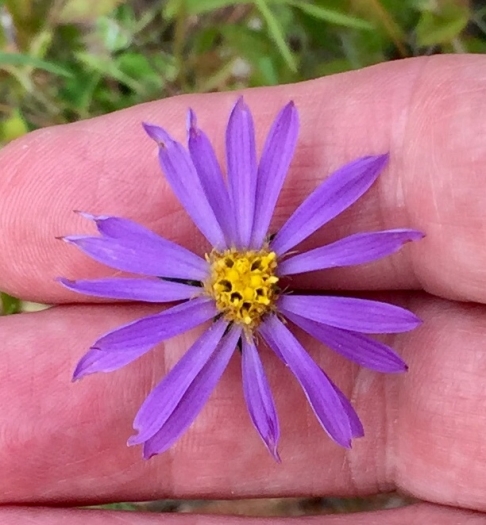Southern Swamp Aster
(Eurybia paludosa)
Southern Swamp Aster (Eurybia paludosa)
/
/

Ken Kneidel
Public Domain
Image By:
Ken Kneidel
Recorded By:
Copyright:
Public Domain
Copyright Notice:
Photo by: Ken Kneidel | License Type: Public Domain | License URL: http://creativecommons.org/publicdomain/zero/1.0/ | Rights Holder: Ken Kneidel | Publisher: iNaturalist | Date Created: 2020-09-24T17:40:25Z |




































Estimated Native Range
Summary
Eurybia paludosa, commonly known as the Southern Swamp Aster, is an herbaceous perennial native to wetland margins, swamps, and low-lying wooded areas in the southeastern United States, specifically the Carolinas, Georgia, and Florida. It typically grows to a height of 1-3 feet (0.3-0.9 meters) and spreads 1-2 feet (0.3-0.6 meters). The plant features lanceolate leaves and produces flower heads from late summer through fall, which display deep lavender to purple rays with yellow centers, providing a showy display in the garden. The Southern Swamp Aster is not to be confused with the Southern Prairie Aster (Eurybia hemispherica), which occupies different habitats and regions.
The Southern Swamp Aster is valued for its late-season blooms and ability to thrive in moist conditions, making it suitable for rain gardens, wetland restoration projects, and naturalized areas. It is also a nectar source for butterflies and other pollinators. This aster prefers part shade but can tolerate full sun in cooler climates, provided it has consistent moisture. It is adaptable to various soil types, as long as they are well-drained. While generally low-maintenance, it can be susceptible to powdery mildew in overly humid conditions. Gardeners should be aware that, despite its beauty, it can spread aggressively in optimal conditions.CC BY-SA 4.0
The Southern Swamp Aster is valued for its late-season blooms and ability to thrive in moist conditions, making it suitable for rain gardens, wetland restoration projects, and naturalized areas. It is also a nectar source for butterflies and other pollinators. This aster prefers part shade but can tolerate full sun in cooler climates, provided it has consistent moisture. It is adaptable to various soil types, as long as they are well-drained. While generally low-maintenance, it can be susceptible to powdery mildew in overly humid conditions. Gardeners should be aware that, despite its beauty, it can spread aggressively in optimal conditions.CC BY-SA 4.0
Plant Description
- Plant Type: Herb
- Height: 1-2.5 feet
- Width: 1-2 feet
- Growth Rate: Moderate
- Flower Color: Yellow, Purple
- Flowering Season: Summer, Fall
- Leaf Retention: Deciduous
Growth Requirements
- Sun: Part Shade
- Water: Medium, High
- Drainage: Medium, Fast
Common Uses
Bee Garden, Bird Garden, Butterfly Garden, Rock Garden, Showy Flowers, Water Garden
Natural Habitat
Wetland margins, swamps, and low-lying wooded areas in the southeastern United States
Other Names
Common Names:
Scientific Names: , Aster grandiflorus, Eurybia paludosa, Aster paludosus, Heleastrum paludosum, Aster paludosus subsp. paludosus, Aster paludosus var. paludosus, Diplopappus paludosus, Leiachenis paludosa, Tripolium paludosum,
GBIF Accepted Name: Eurybia paludosa (Aiton) G.L.Nesom